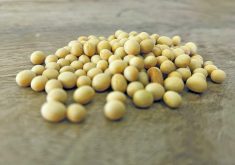In 2017, people in Canada’s seed industry felt hopeful.
Private money was flowing into wheat and pulse crops and investment in variety development was expected to increase in future years.
But that projected investment didn’t pan out, particularly for wheat and other cereal crops.
Private firms backed away from cereal crop innovation for the Prairies, mostly because a decent return on investment is doubtful in Canada.
“It’s really difficult to come to Canada and say, ‘I’m going to make some money at this,’” said Lauren Comin, regulatory affairs manager with Seeds Canada, which represents seed growers, breeders, distributors, processors, retailers and others in the seed value chain.
Read Also

Why feds imposed EV tariffs
Moe and Kinew have a fight on their hands when it comes to eliminating the EV tariff. Canada has to worry about pissing off the U.S. and Mexico and hundreds of thousands of auto workers.
“If you’re not making a return… any logical person would say that’s a reason to not make (an) investment.”
In 2018, the Canadian Seed Trade Association published a report on private investment in Canada’s seed sector. The report showed it had reached $171 million in 2017, up 56 percent from 2012, for activities like plant breeding, trait development and variety evaluation.
About 80 percent of the dollars went to canola, soybeans and corn.
But investment in other crops was expanding.
“Major increases are found in wheat, (with) a 237 percent increase over 2012,” the report said. “Pulses went from almost (nothing) to $12.7 million in 2017.”
In 2015, Limagrain started its cereal research program for Canada and along with other investments, there was a sense of optimism.
But in the fall of 2019, Syngenta closed its cereal research and breeding programs in Canada.
Then, this year, BASF halted its hybrid wheat breeding program.
“Both of those multi-national programs pulling out of Canada, don’t bode well for investment in at least wheat,” said Todd Hyra, western business manager for Secan, the largest supplier of certified seed to Canadian farmers.
About a decade ago, the federal government introduced a bill committing Canada to international plant breeding standards known as UPOV 91.
The government amended the Plant Breeders Rights Act, boosting intellectual property rights and creating an opportunity to make money from crop development.
With the changes, private investment gathered momentum.
“After 2015, when the PBR Act was amended, so we were compliant with UPOV91. I think there was a lot of hope at that time,” said Comin, who was research director for Alberta Wheat and Barley before joining Seeds Canada.
“(But) we didn’t quite see the positive changes following through.”
Things may have gone off the rails in 2018-19, when Agriculture Canada and the Canadian Food Inspection Agency held consultations with farmers and industry groups about value-creation in the seed sector.
At the heart of the discussion was “whether Canadian farmers should be expected to pay trailing or back-end royalties on the use of farm-saved seed,” so plant breeders receive a reasonable return on their investments, The Western Producer reported in 2019.
Those consultations were unsuccessful.
Sweeping changes to the royalty system did not happen. Farmers continue to use farm-saved seed and pay no royalty.
“It (the failure) was a pretty big deal,” Comin said, because private firms don’t have a structure to capture value from their investments.
Without royalties on farm-saved seed, crop developers must rely on sales of certified seed. But few farmers in Western Canada use certified seed for cereal crops.
“It could be 25 percent or lower, depending on the year,” Comin said. “When there is such low certified seed use, companies aren’t getting a return on their investment.”
One step toward a better return on investment is a system called the Variety Use Agreement (VUA), which has been in place since 2020.
Secan has a couple of barley varieties, from Europe, that use the VUA system.
If a producer wants to use their farm-saved seed for that barley, they pay the breeder a royalty. It could be $2 per acre.
That modest change will reward some breeders, but growers have options. They can choose to use farm-saved seed for a variety that doesn’t have a VUA.
“The variety has to have something special,” to encourage growers to sign a VUA, Hyra said.
Other companies are testing barley, oat and rye varieties from Europe or the United States, to see if they perform in Western Canada.
Some genetics could succeed on the Prairies, but it’s not the same as a developing a wheat or oat crop for Western Canada.
“(Cereal) varieties aren’t being specifically bred for Canada, by private investors,” Comin said. “We’re not seeing the initial risk taken in Canada.”
There’s also the issue of spring wheat.
It’s unlikely that a wheat variety from France will be suited for the disease issues and growing conditions in Saskatchewan.
“In the case of wheat, rarely do wheat varieties move well into Western Canada,” Hyra said.
Agriculture Canada still employs wheat, oat and barley breeders and public funding for crop development continues.
As well, commodity groups like SaskWheat support breeding through the Canadian Wheat Research Coalition, which boosts funding for public programs.
But the public system has shrunk.
As an example, Agriculture Canada now only has two Canada Western red spring wheat breeders. That’s two people for a crop seeded on nearly 20 million acres.
“I think the piece that many miss is the erosion that’s (happened) in the public system over the last decade,” Hyra said. “People forget about the research stations that have closed and the breeders that have left.”
There’s also the matter of speed.
Public breeding programs in Canada have produced world class varieties and Agriculture Canada plant breeders are top-notch. But government moves slowly relative to the private sector, so innovation doesn’t happen at the required pace.
If Canada isn’t an attractive place for investment, farmers in other regions will likely get the latest technology and best crop varieties years before Canadian producers.
“Where intellectual property rights are not clear, not understood or not enforced, innovation suffers,” said the 2018 CSTA report.
















